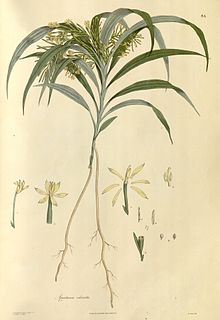Apostasia (plant)
| Apostasia | |
|---|---|

| |
| Apostasia wallichii | |
| Scientific classification | |
| Kingdom: | |
| (unranked): | |
| (unranked): | |
| Order: | |
| Family: | |
| Subfamily: | |
| Genus: | Apostasia Blume, 1825
|
| Species | |
|
See text. | |
| Synonyms[1] | |
Apostasia is a genus of primitive orchids (family Orchidaceae), comprising 7 terrestrial species.
The genus is distributed in humid areas of the Himalayan region, China, India, Sri Lanka, Southeast Asia, New Guinea, and Queensland.[2]
The species of Apostasia produce an erect inflorescence with up to six lateral branches, arising from the main, elongated root. Their warty tubercles are swollen and stalked. They lack velamen.
They bear up to 30 white or yellow flowers. The flowers of Apostasia species are non-resupinate (i. e. not turned upside down), as in the other orchids.
Like Neuwiedia with 3 fertile stamens, the other genus of the same subfamily, Apostasia is noted for having 2 fertile, abaxial stamens instead of one like other orchids. The possession of 2-3 abaxial anthers is autapomorphous (= a derived characteristic unique to a taxon) in the Apostasioideae. Apostasia nuda, Apostasia elliptica and Apostasia latifolia lack a staminode. This loss of a staminode is an apomorphy (= derived characteristic). The other species are characterized by a staminode that is homologous to the only stamen of monandrous orchids. This presence of a staminode defines an ancestral trait (= plesiomorphic).
Because of that primitive feature, some authority did not consider Apostasia as real orchids. Nevertheless, the difference between these genera and outgroups in cladistic analysis is larger than with the rest of the orchids. They are therefore included within the orchid family.
Species
- Apostasia elliptica J.J.Sm., 1920.
- Apostasia latifolia Rolfe, 1889.
- Apostasia nuda R.Br. in N.Wallich, 1830.
- Apostasia odorata Blume, 1825.
- Apostasia parvula Schltr., 1906.
- Apostasia ramifera S.C.Chen & K.Y.Lang, 1986.
- Apostasia wallichii R.Br. in N.Wallich, 1830.
References
- Stern, W. L.; V. Cheadle; J. Thorsch (1993). "Apostasiads, systematic anatomy, and the origins of Orchidaceae". Botanical Journal of the Linnean Society. 111: 411–45. doi:10.1111/j.1095-8339.1993.tb01913.x.
- A. Kocyan; Y.-L. Qiu; P. K. Endress; E. Conti (2004). "A phylogenetic analysis of Apostasioideae (Orchidaceae) based on ITS, trnL-F and matK sequences". Plant Syst. Evol. 247: 203–213. doi:10.1007/s00606-004-0133-3.
- Pridgeon, A.M.; Cribb, P.J.; Chase, M.W. & F. N. Rasmussen (1999): Genera Orchidacearum Vol.1, Oxford U. Press. ISBN 0-19-850513-2
